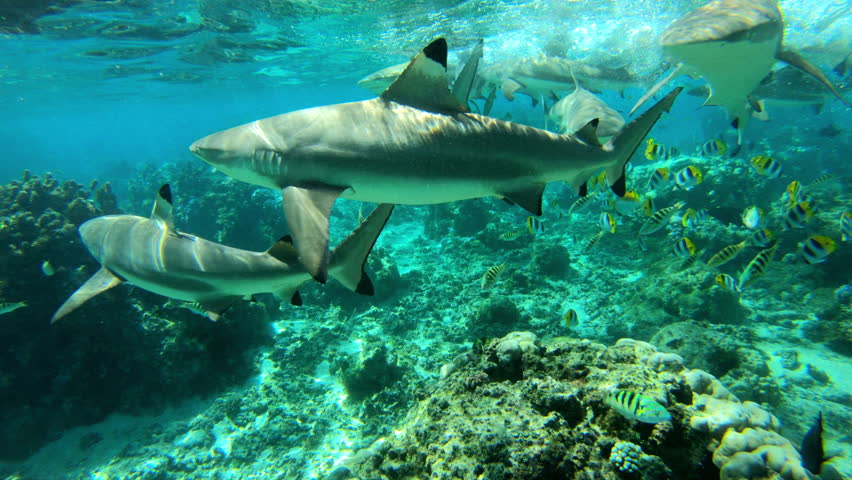ANIMAL: Blacktip Reef Shark Carcharhinus melanopterus Type of Animal: Requiem Shark Habitat: Tropical/subtropical areas: coral reefs/surrounding areas, nearshore/coastal waters, reef ledges/reef drop-offs, shallow sandy flats, atolls, brackish estuaries/lakes, channels between reef flats, mangroves, freshwater areas near sea sometimes, younger animals prefer shallower areas than adults (though all ages prefer relatively shallow areas), spend lots of time near surface preferring clear water, rarely go deeper than 262 ft. Location(s): Indo-Pacific & far E Mediterranean & Red Sea Appearance: Robust build w/ streamlined body plan, short wide round snout, pale grayish brown above & white below w/ white band on sides extending forward from above anal fin, all fins have black tips hence name. Food/Diet: Ray-finned fish-mullet, small grouper, grunters, jacks, mojarras, wrasses, surgeonfish, smelt-whitings, slipjaws. Also eat squid, octopus, cuttlefish, shrimp, mantis shrimp, snakes, seabird chicks, young sea turtles, very small sharks & rays, rats that fall off ships. Status in Wild: Stable Conservation: Breeding in aquariums, marine parks, & zoos Lifestyle: Schools of 10-20 sharks. They often hunt in packs. Additional Info: Called: Male Female Young-Pup Group-School Weight: Male: 20 lbs Female: 25 lbs Gestation: 7-11 months Life Span: 13 years Body Length: Male: 3-5 ft Female: 3.1-5.9 ft Young: 2.4 ft Tail Length: 7.87 in Main predators of adults are larger sharks, large groupers, & crocodiles. Young preyed on by adults of own species, many larger fish, & birds among others. These sharks are viviparous (embryo develops inside mom’s body), giving birth to live young. Depending on population, they can breed biennially (every other year), biannually (twice a year), and/or annually. Potential threats include water pollution, accidental bycatch, & fishing for meat/fins/liver oil. When threatened, they’ll form S-shape w/ bodies & roll from side-to-side. Like all sharks, they have electroreceptors allowing them to detect electric current of nearby prey. Sexually mature at around 4 years old. These sharks tend to be non-migratory though far southern & northern populations may migrate. Like all sharks, males have claspers on pelvic fins while females don’t. Fun Fact(s) Australian Aborigines harvest these sharks, preparing dish called buunhdhaarrr in which liver/flesh boiled separately, then minced/mixed together. Parthenogenesis (embryo development of unfertilized egg) has occurred rarely in this species. They’ve been seen breaching out of the water, especially around feeding time. Rather docile species unless provoked. Almost all attacks occurred because they were provoked or in cases of mistaken identity (i.e. biting legs of waders since moving legs might resemble natural prey). They’re rather shy & very skittish, spooking easily. Can be more aggressive in areas where spear-fishing frequent.
